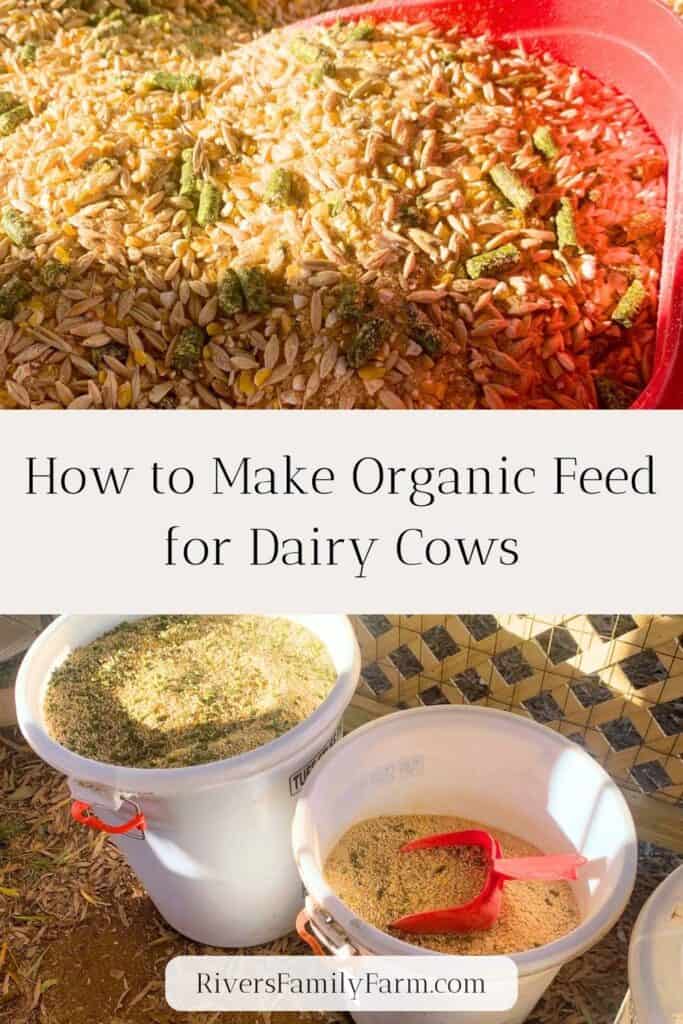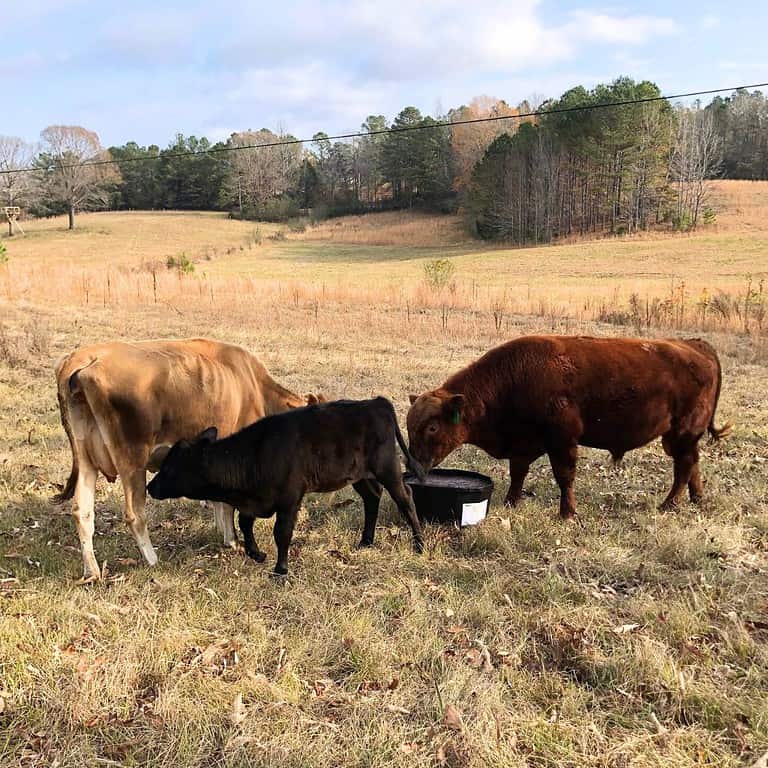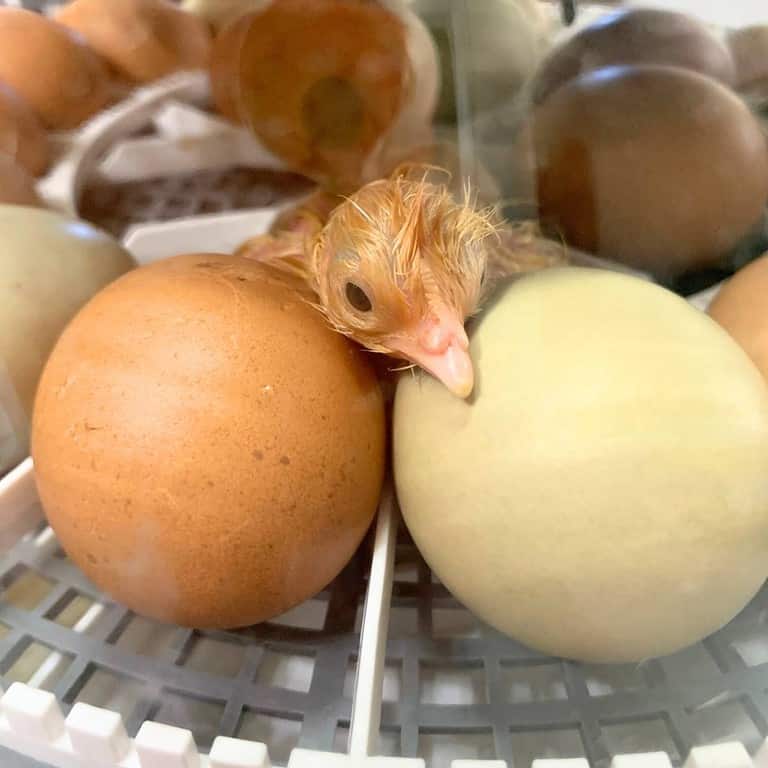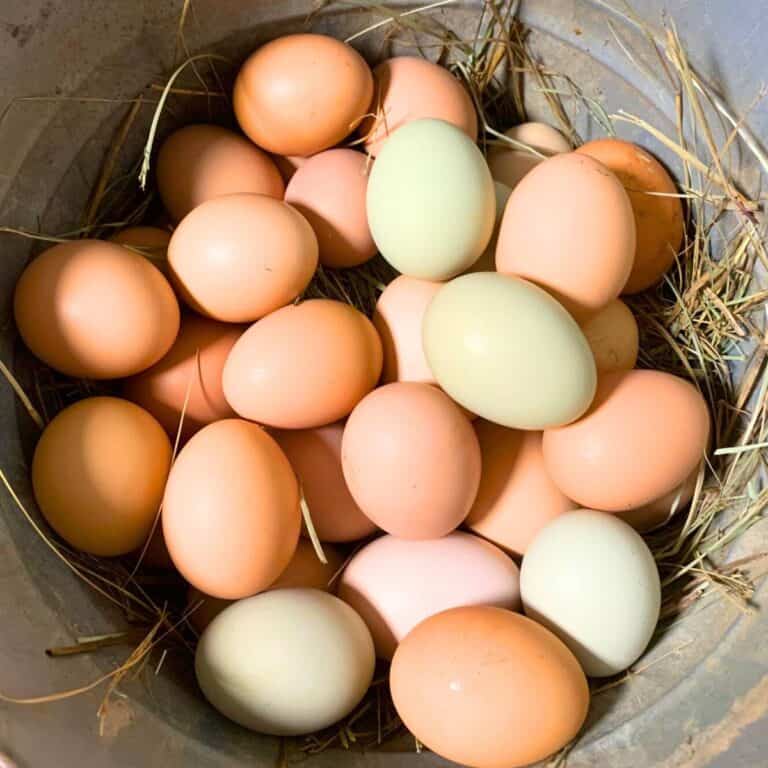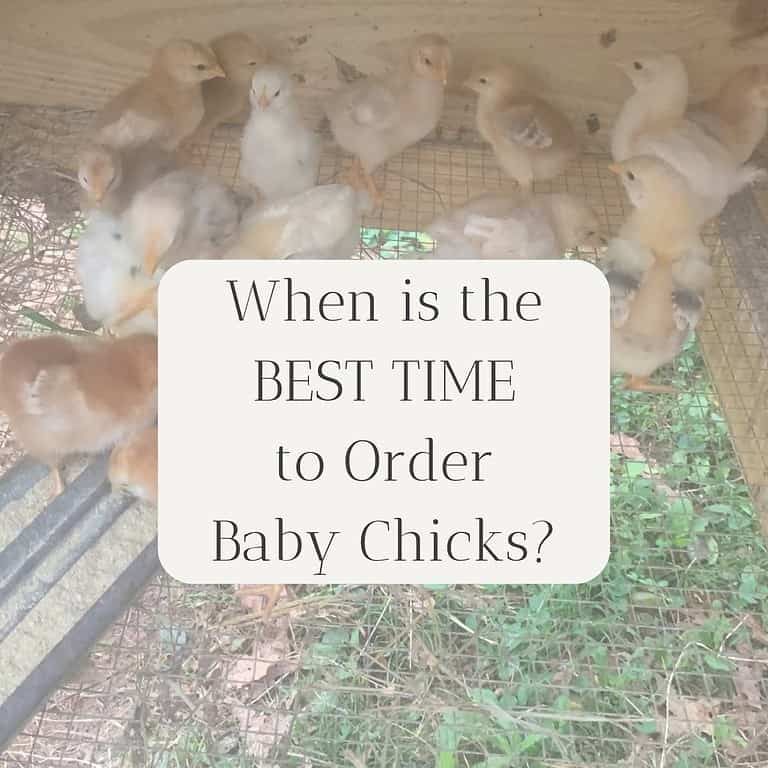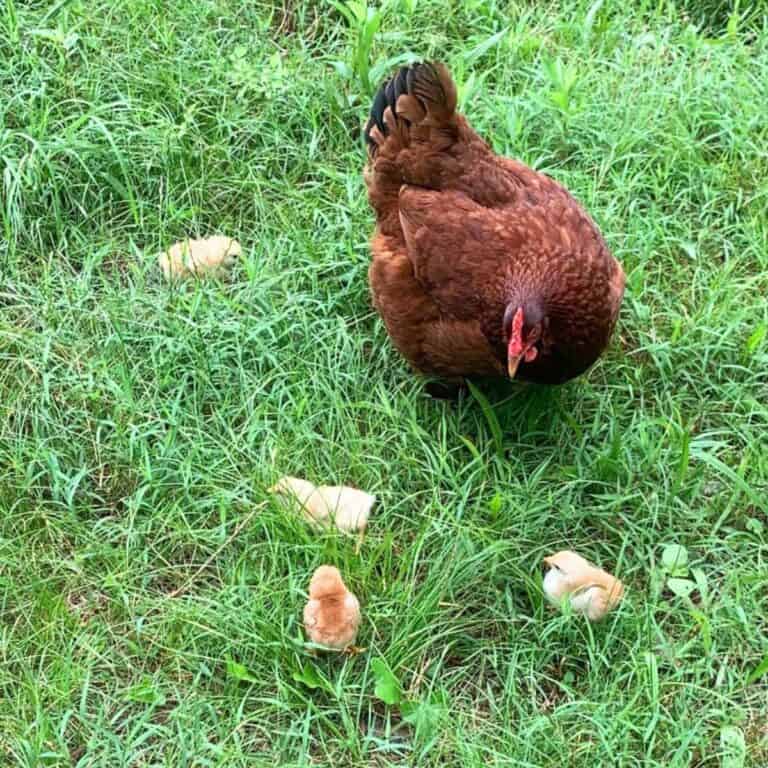How to make organic feed for dairy cows at home
I’ll show you the five ingredients we use to make organic feed for dairy cows at home, how much we feed our cows, and how feeding grain affects milk production!
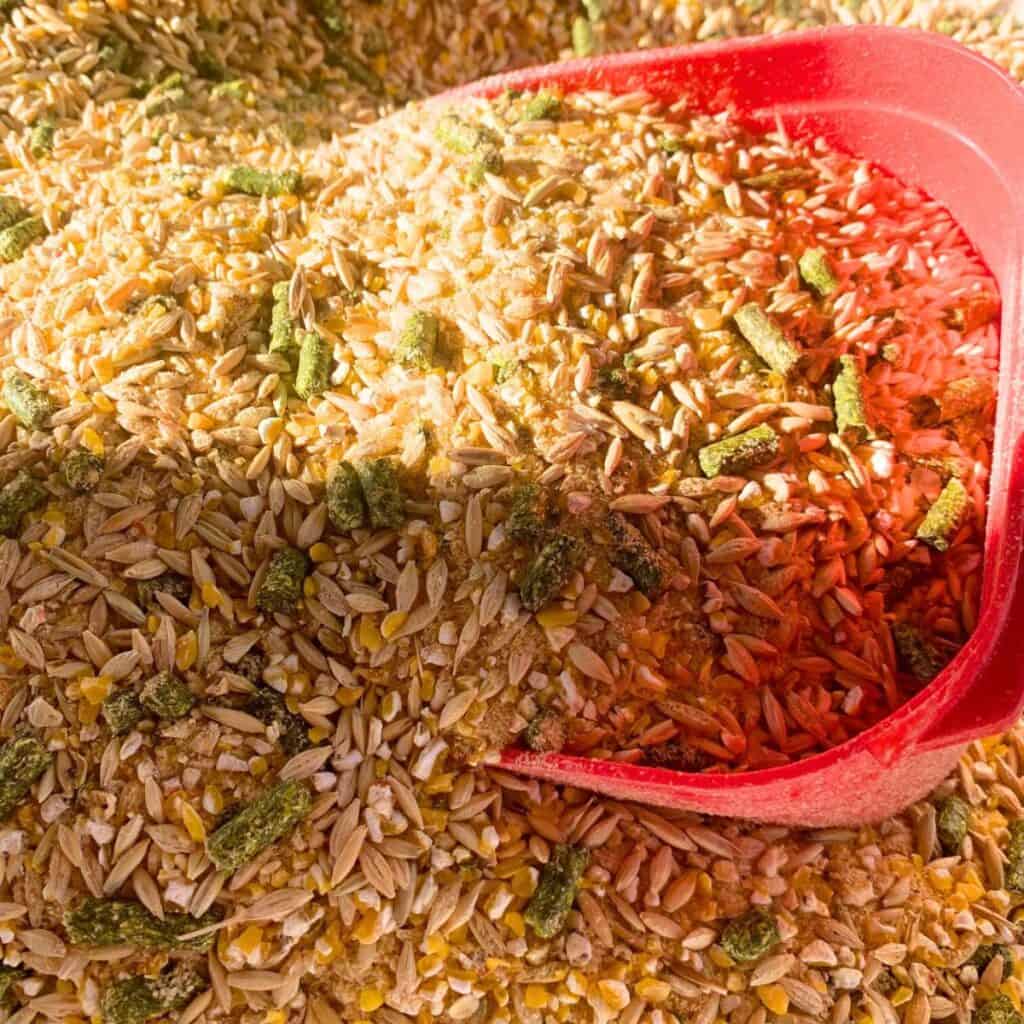
It’s no secret that I love my first dairy cow, Belle, plus the newcomers Bossy and Blondie. They provide milk and dairy products for my family plus calves that we raise for meat.
In the South where I live, it’s hard to near impossible to find organic feed for animals. Big box stores sell small bags, but they are cost prohibitive for my family because of the quantity we would need to buy.
Most of the animal feed sold near me is not organic. And that means that they are likely laced with pesticides and herbicides.
The only way to know for sure would be to test the food individually. And while I’m not opposed to doing that, it would be costly. So I stick with high quality organic animal feed that I buy in bulk from Azure Standard. It’s the best place that I have found to get high quality organic animal feed for a cheap price.
How to make organic feed for dairy cows at home.
This recipe is so simple. And you can adjust it to suit your needs and what you can purchase.
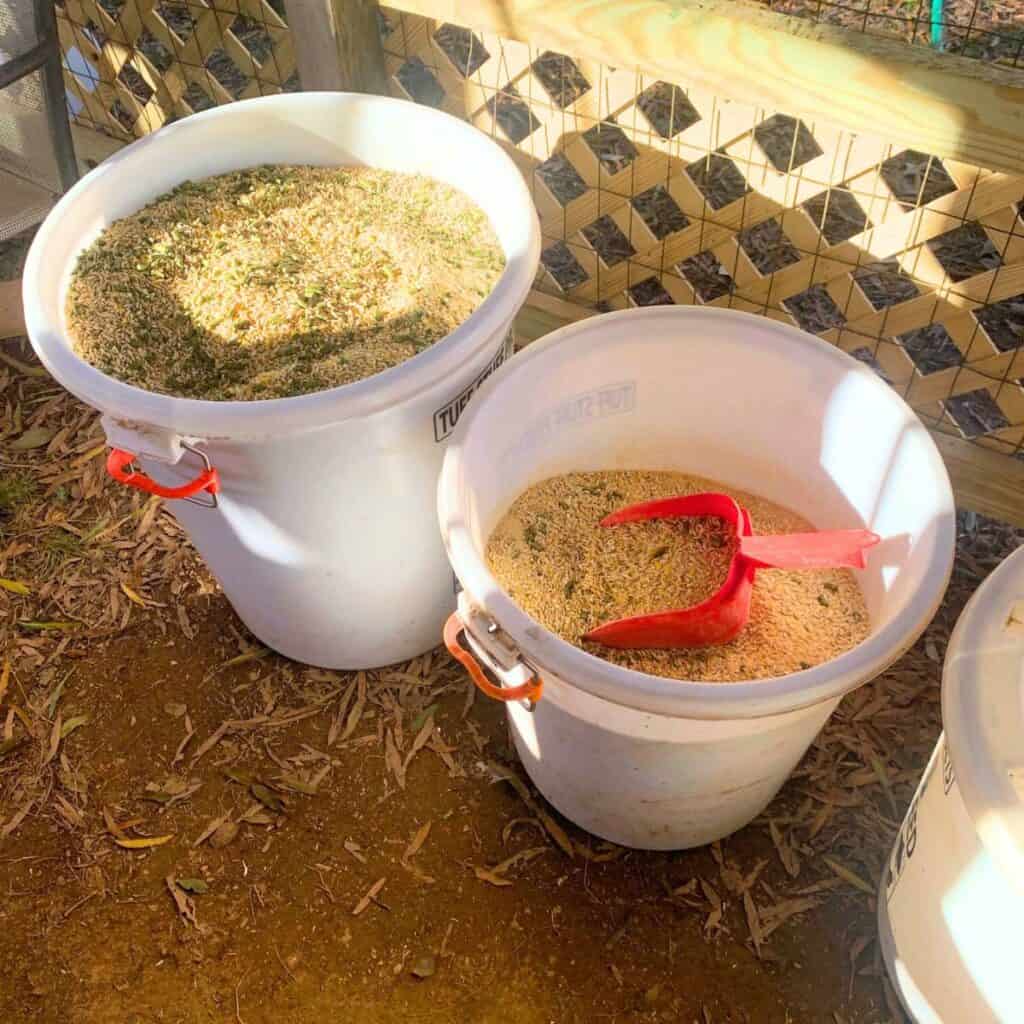
A lot of commercial dairy cows like Holstein cows are bred to produce an abundant supply of milk. That said, they require a lot of grain in order to stay healthy while producing the amount of milk that they were bred for.
Alternatively, homestead cows like Jersey cows don’t produce quite as much milk and can get away with just eating grass as long as your pasture is thick and lush. If your pasture is not that great, they would need some grains, too.
This post contains affiliate links, which means I make a small commission at no cost to you if you place a qualifying purchase through any of the links. Read my full disclosure here. Thanks for your support!
Ingredients
I want to encourage you to make organic feed for dairy cows at home for a fraction of the cost by ordering animal feed from Azure Standard. They have food trucks that go all over the country each month, so you are likely to have a drop point near your home or farm! You can also get it delivered to your house by paying extra.
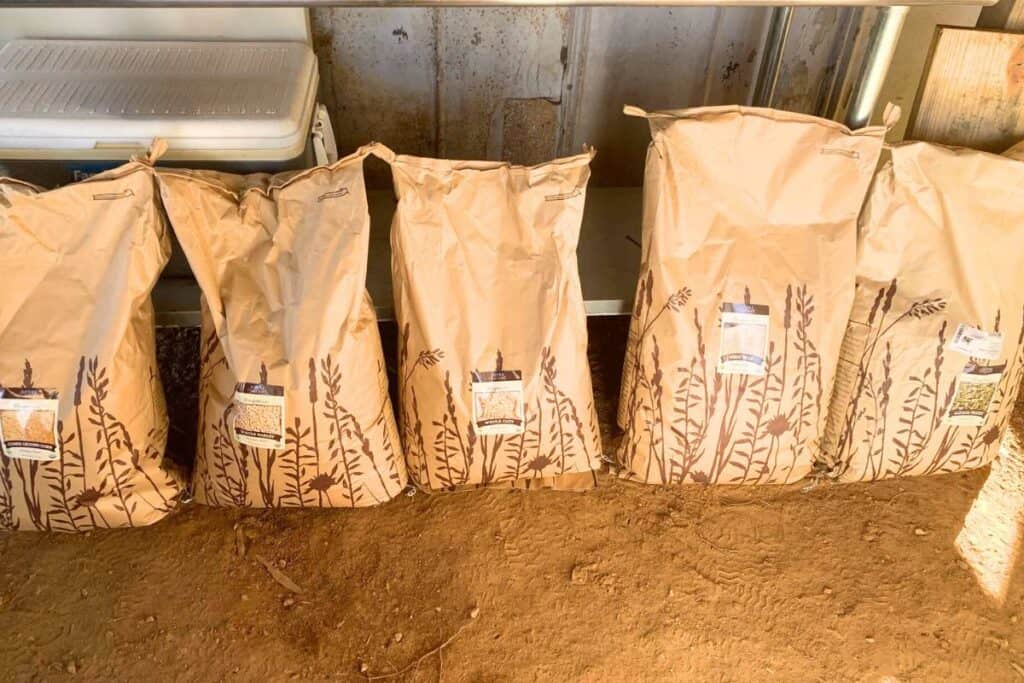
Barley – Whole barley from Azure Standard comes in 45-pound bags. It contains an outer hull that has 70 to 80 percent of TDN (total digestible nutrients) and 7 to 10 percent of digestible protein. This ingredient helps the cows produce more milk, too!
Oats – Whole oats with hulls have not had the husk (hull) removed, and it comes in 30-pound bags from Azure.
Wheat bran – Wheat bran from Azure comes in 25-pound bags. It’s the outer most covering of wheat that is left over after Azure mills their flour. It has 14 to 17 percent protein, 3 to 4.5 percent fat, and 10.5 to 12 percent fiber. The protein-rich wheat bran will help your cows produce more milk, too!
Alfalfa pellets – The larger 6mm Alfalfa pellets we get from Azure come in 40-pound bags. It’s a rich, bright green color that smells fresh. It has 16 to 21 percent protein, which makes dairy cows produce an abundant supply of milk, and 26 to 30 percent fiber. You can soak the pellets if you want, but our cows don’t have any trouble chewing or swallowing Azure’s brand. Some other brands we have tried are too hard, though, in my opinion.
Coarse ground corn – This is optional, but I like my cows to have coarse ground corn. This comes from Azure in 50-pound bags. It has 6.5 percent protein and 2 percent fiber.
The current average price for all five ingredients is $0.59/pound.
Pro Tip:
Try to only buy what you will use up in a month or two. And make sure that you store it away from any moisture so that mold won’t start to form. You should never give your dairy cows moldy food or food infested with insects.
One of the benefits of giving corn and other grains is that our free-range chickens will scratch through cow patties in the pasture to get small bits that were left undigested. It sounds gross but is completely natural. That’s why you find birds and cattle often grazing together. It keeps the pastures looking clean!
Tools you may need
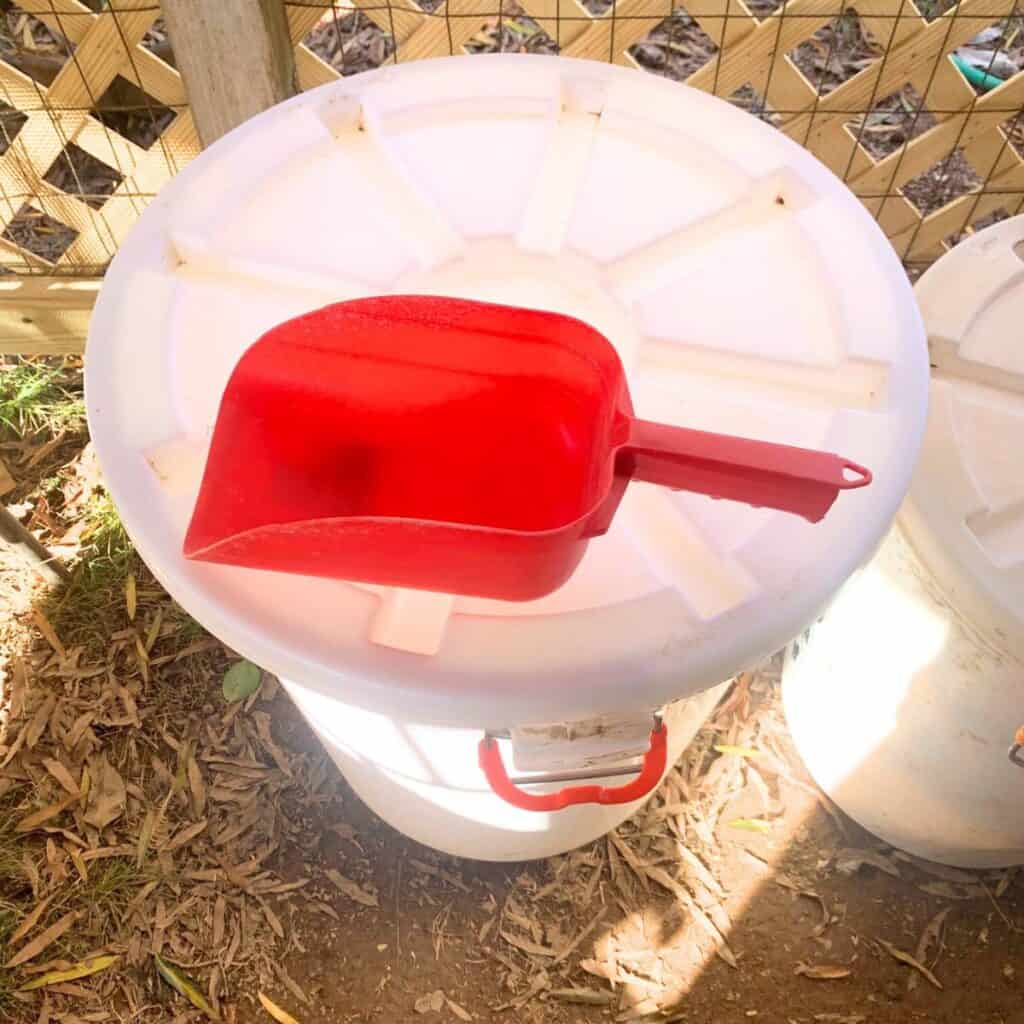
Large container with lid – I like big round tubs to store our feed in, and we use 26.5 gallon locking tubs with lids. They’re expensive but really tough. We’ve tried other options, but rats and mice are an issue where we live and they will chew holes into other storage containers to get to the grains. They haven’t been able to do that with these bins. Alternatively, you could use a metal garbage bin with lid.
Animal feed scooper – We mostly use 5-pint utility scoops but we have 3-quart scoops, too.
Steps to make organic feed for dairy cows
To make organic feed for dairy cows, add a mixture of organic alfalfa pellets, organic barley, organic oats with the hulls, organic wheat bran, and organic coarse ground corn (or cracked corn). See below for reasons and recipe variations.
You could give your cows straight alfalfa pellets but it will be more expensive to feed your cows in the long run. And it’s not really necessary. You’re just looking to give your cows something tasty, that increases milk production, and helps them stand still in the stanchion long enough for you to milk out your cow.
I want our dairy cows to have the best stanchion snack!
The first step in making your own dairy cow ration will be to get out all of the ingredients. I line up my feed bags near the storage containers I use.
How to easily open animal feed bags.
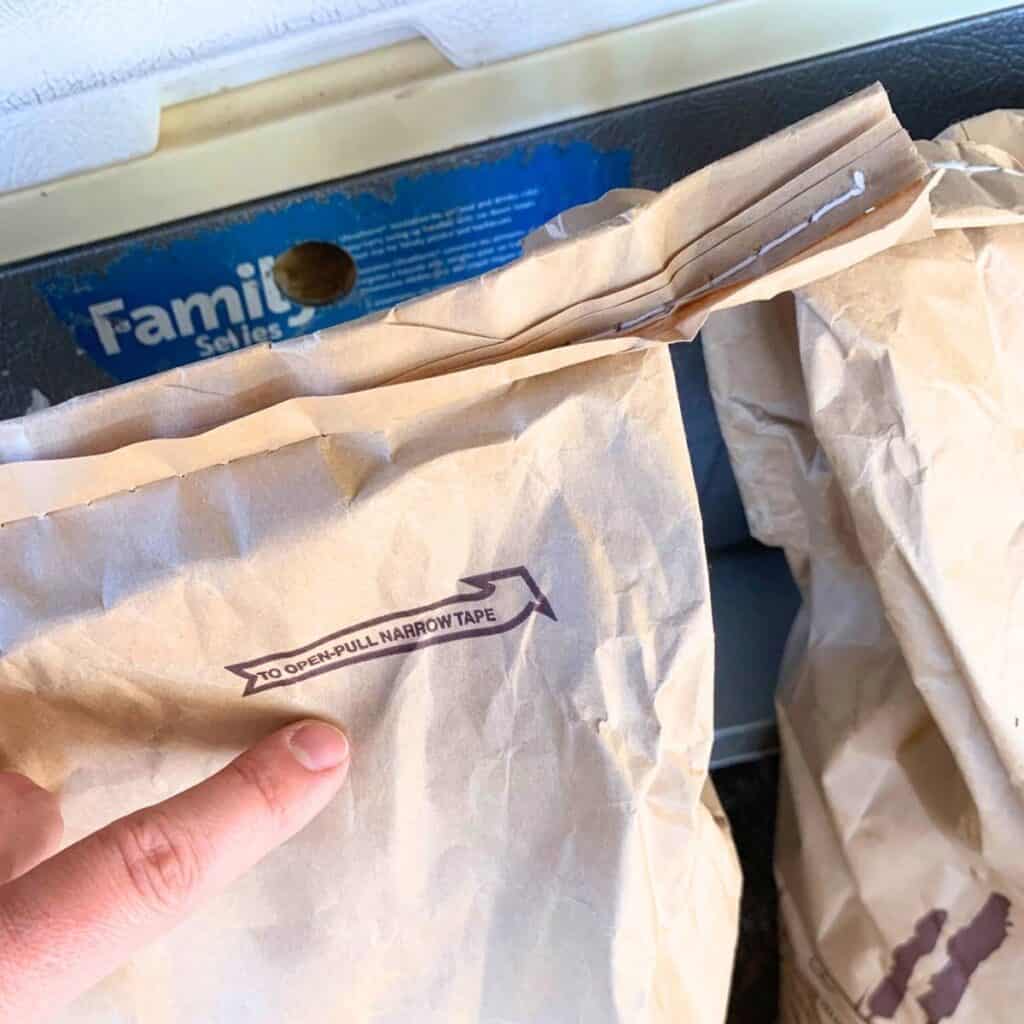
Look for a tab or tape at the top of your feed bags. Generally it’s on the upper right side.
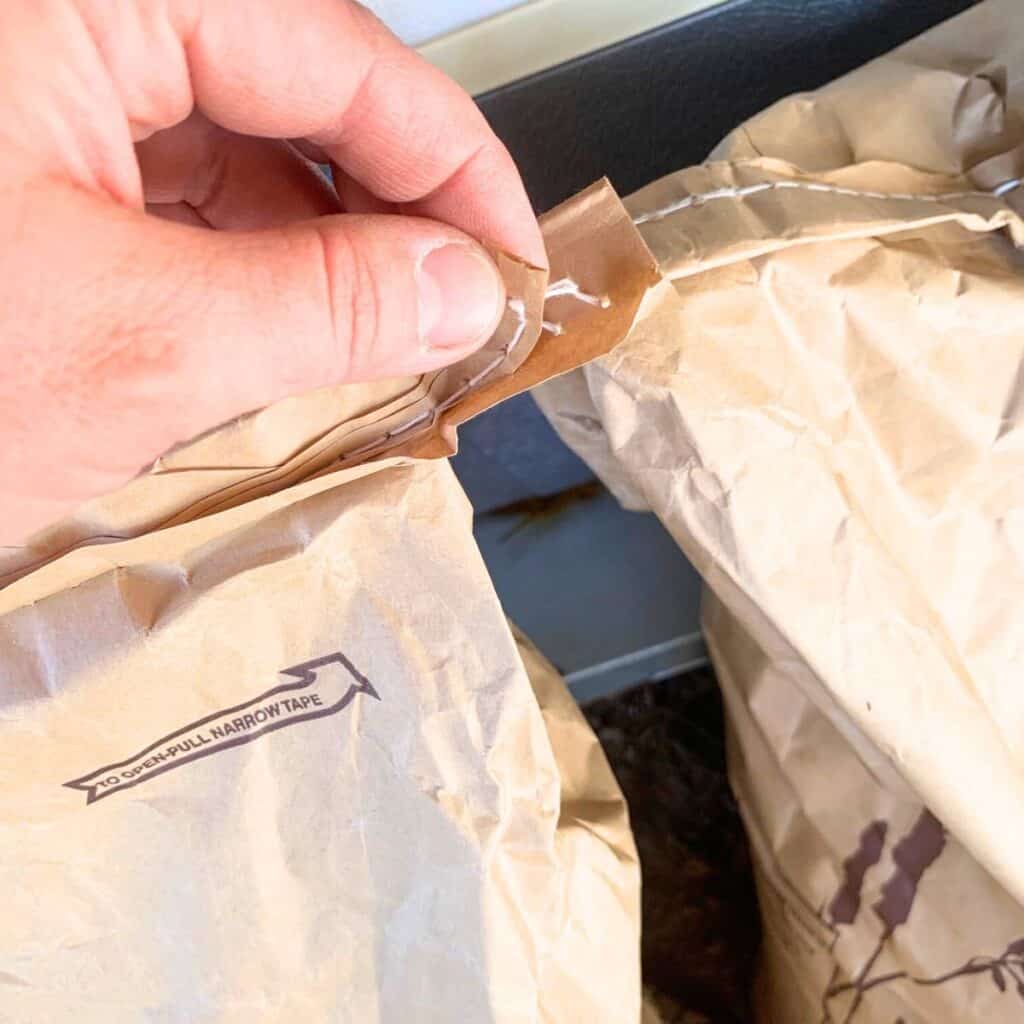
Pull the string and narrow strip of paper. It should start to unravel and will be easy to pull.
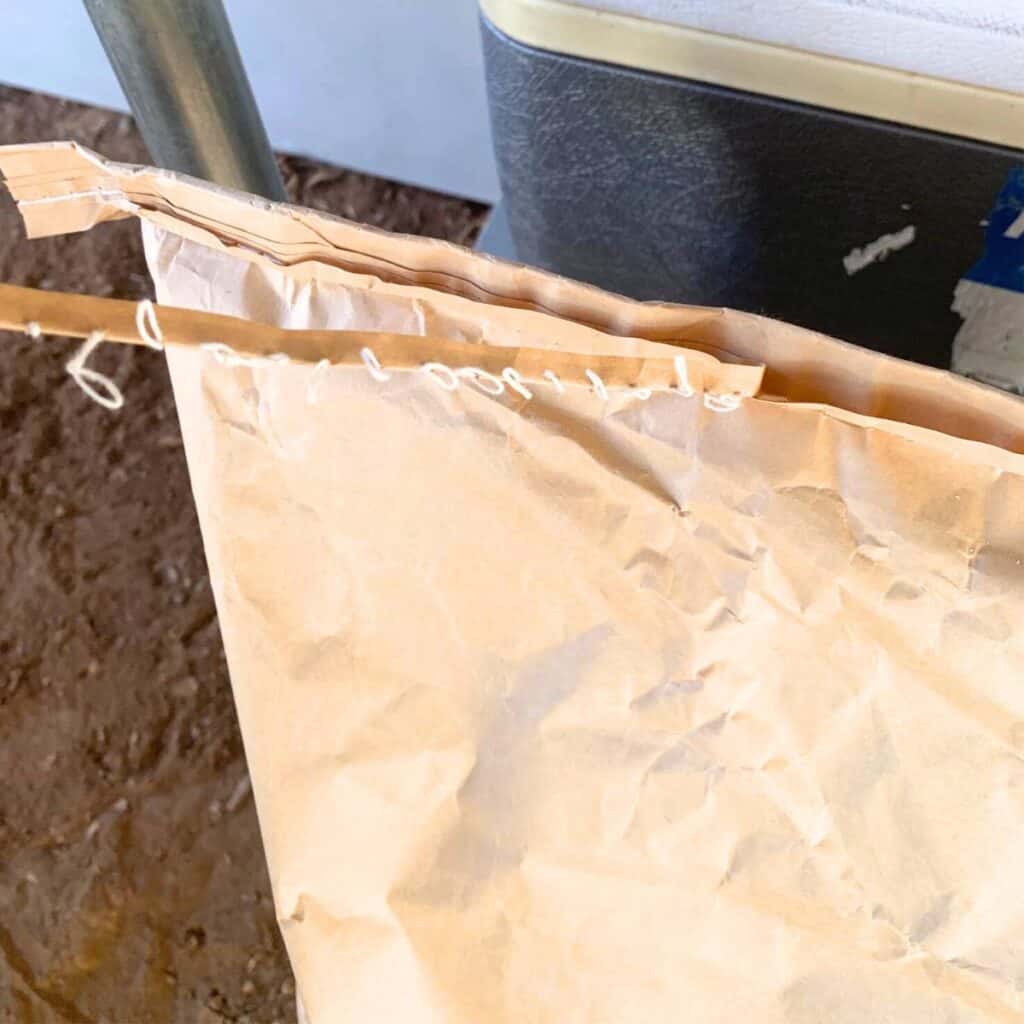
You might need both hands, but keep pulling until you get the whole thing off. Your bag should be wide open if it came with one of these easy-open narrow tapes at the top.
Quick Tip: Make sure you put the string and tape in your pocket to throw it away. The last thing you want is for your chickens or turkeys to get tangled up in the string. And It…Will…HAPPEN!
Mix the organic feed
I find it’s easiest to add the ingredients one by one to the storage container, and then mix it up with the scoop.
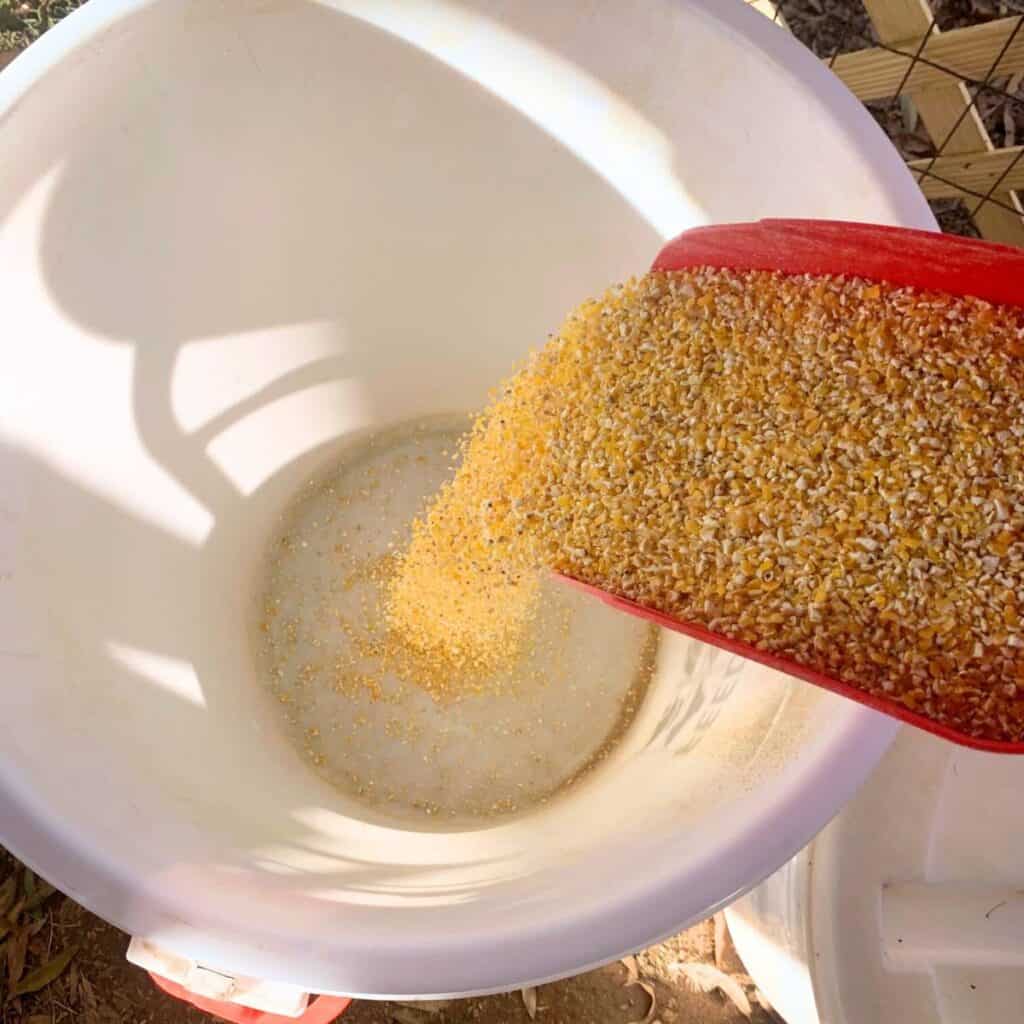
If you’re using cracked corn, add a scoop full to your storage bin.
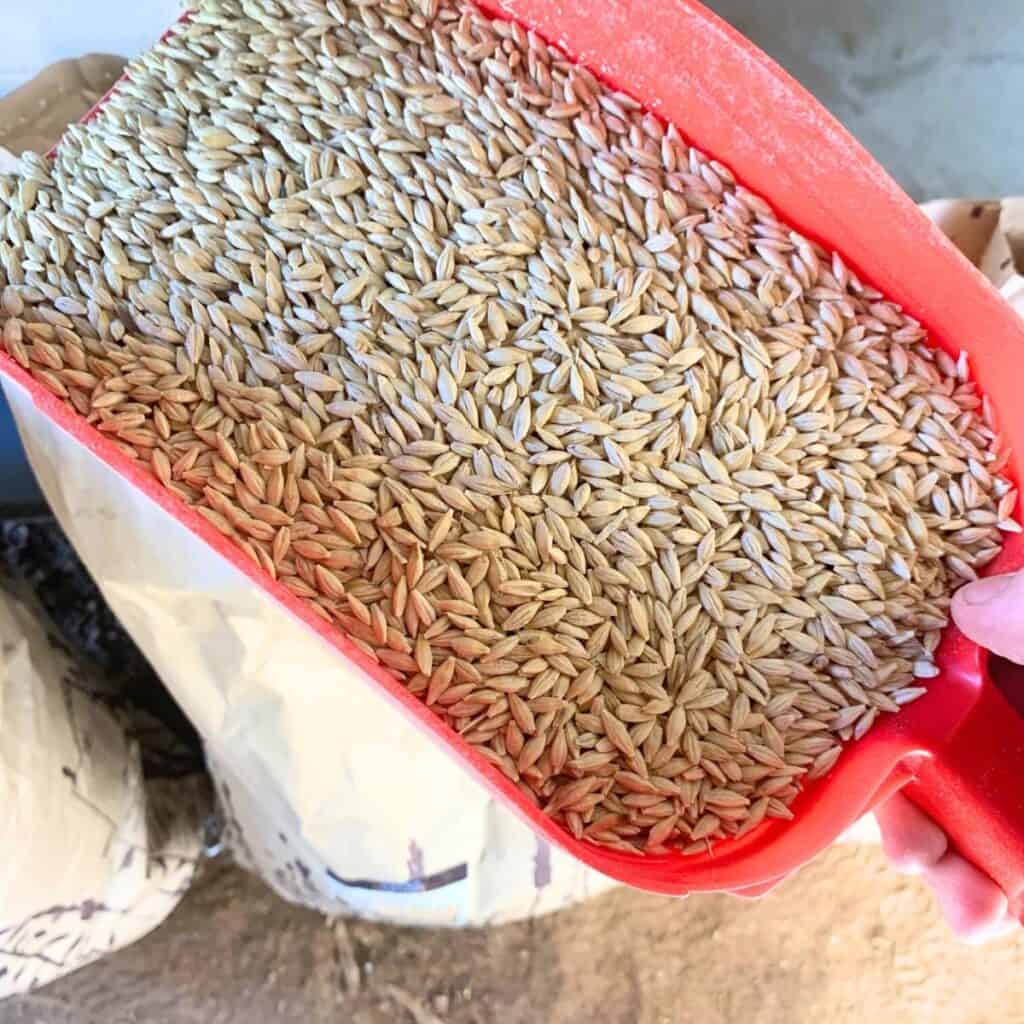
Next, add a scoop of whole barley.
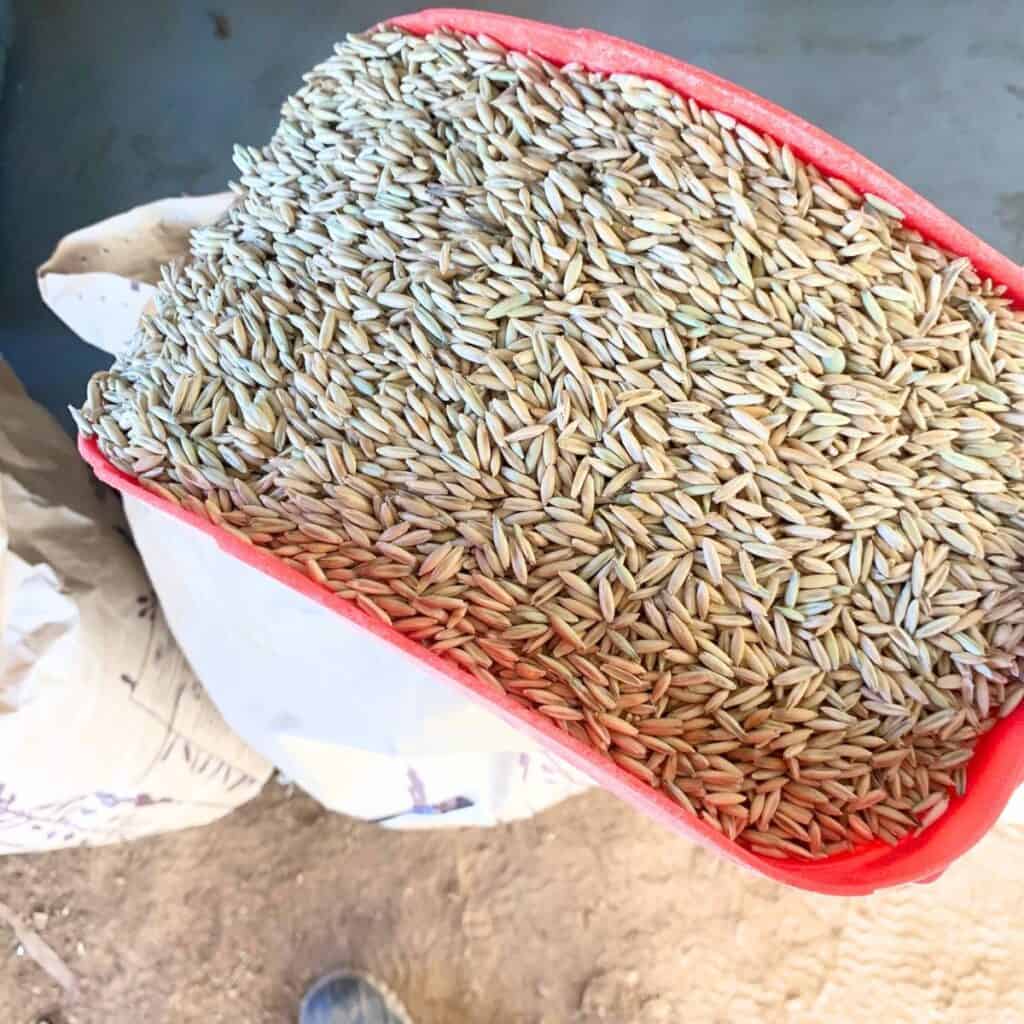
Add a bit less than a full scoop of whole oats. It will look almost identical to the barley. I find that I run out of oats too soon when I use a whole scoop since it comes in a smaller bag size than the others.
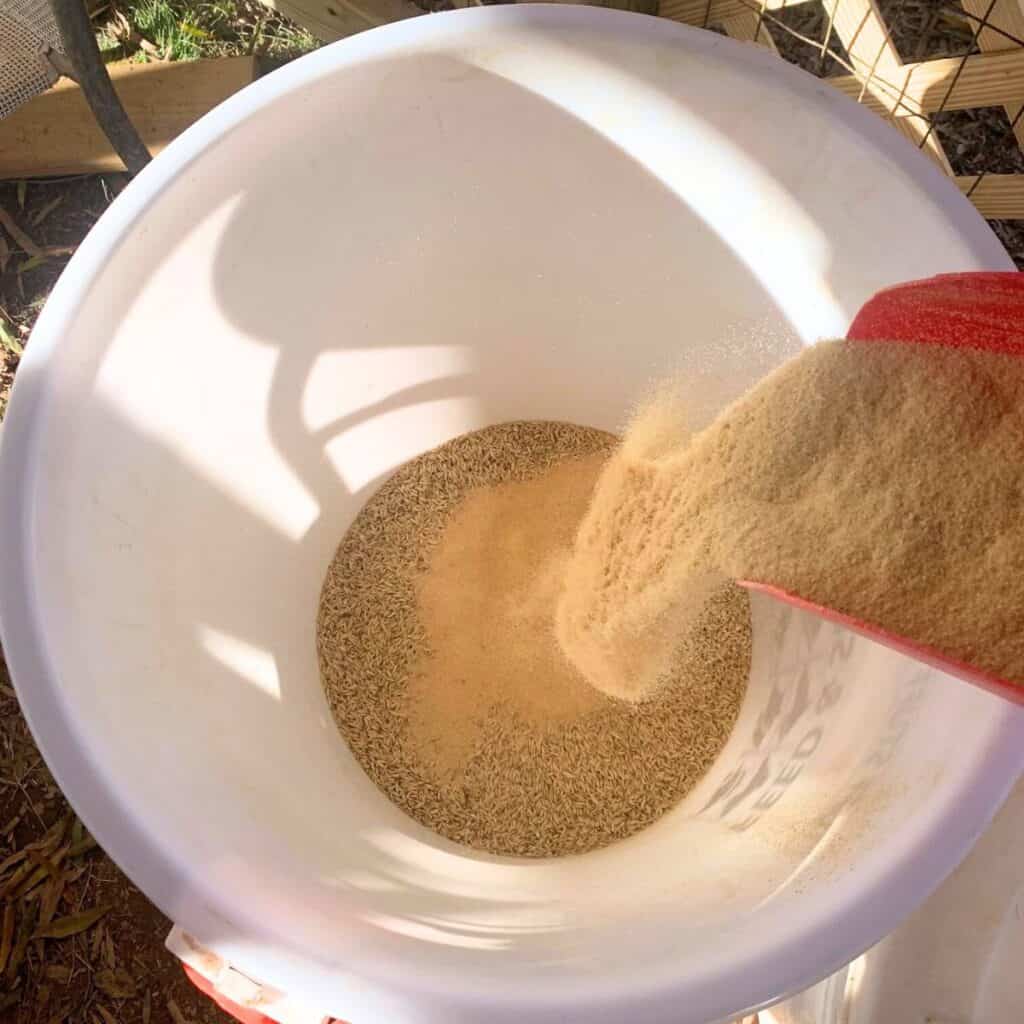
Then add the wheat bran. It’s a powder, so I usually limit it to a half scoop. That’s partially because I don’t want my final product to be too powdery, but it’s also to stretch out the wheat bran since it comes in the smallest bag size (25 pounds).
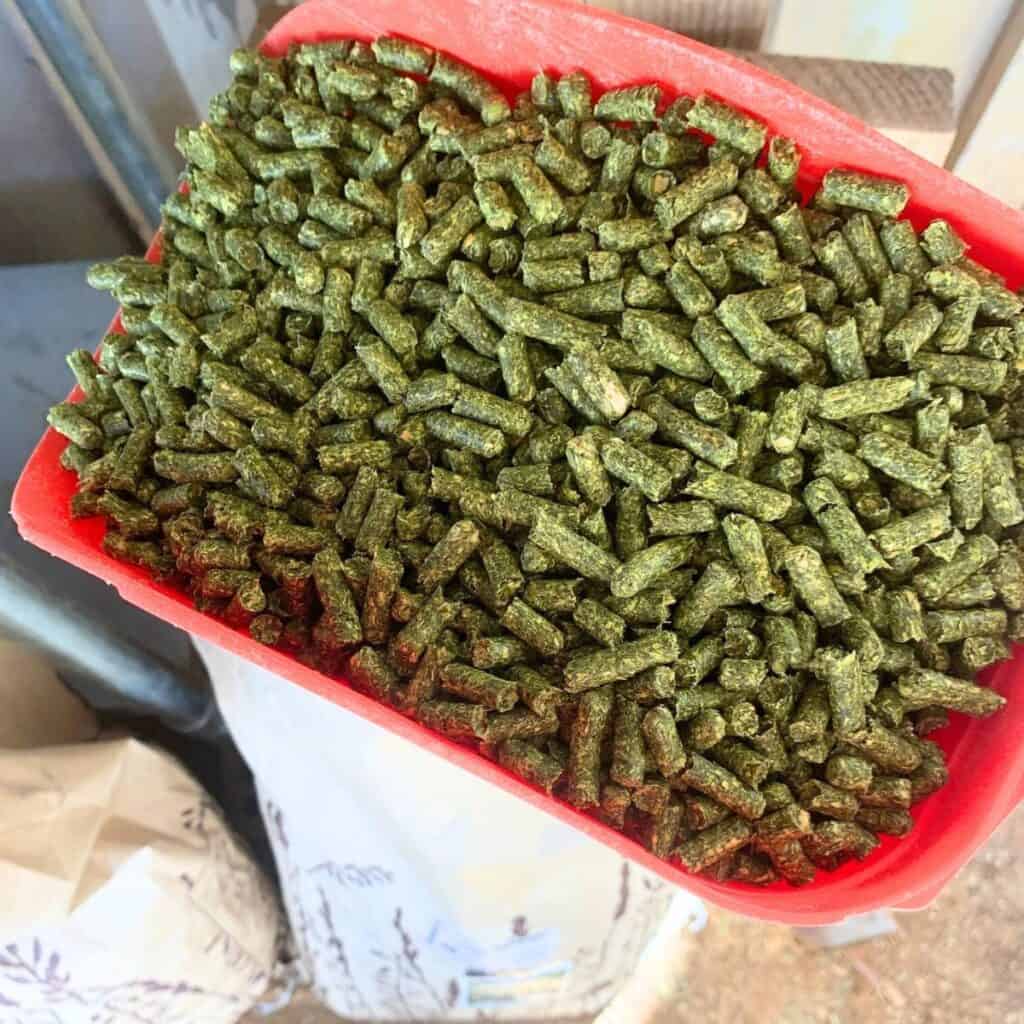
Last, add in the alfalfa pellets. This is the most expensive ingredient, but the queen because it has the highest protein content.
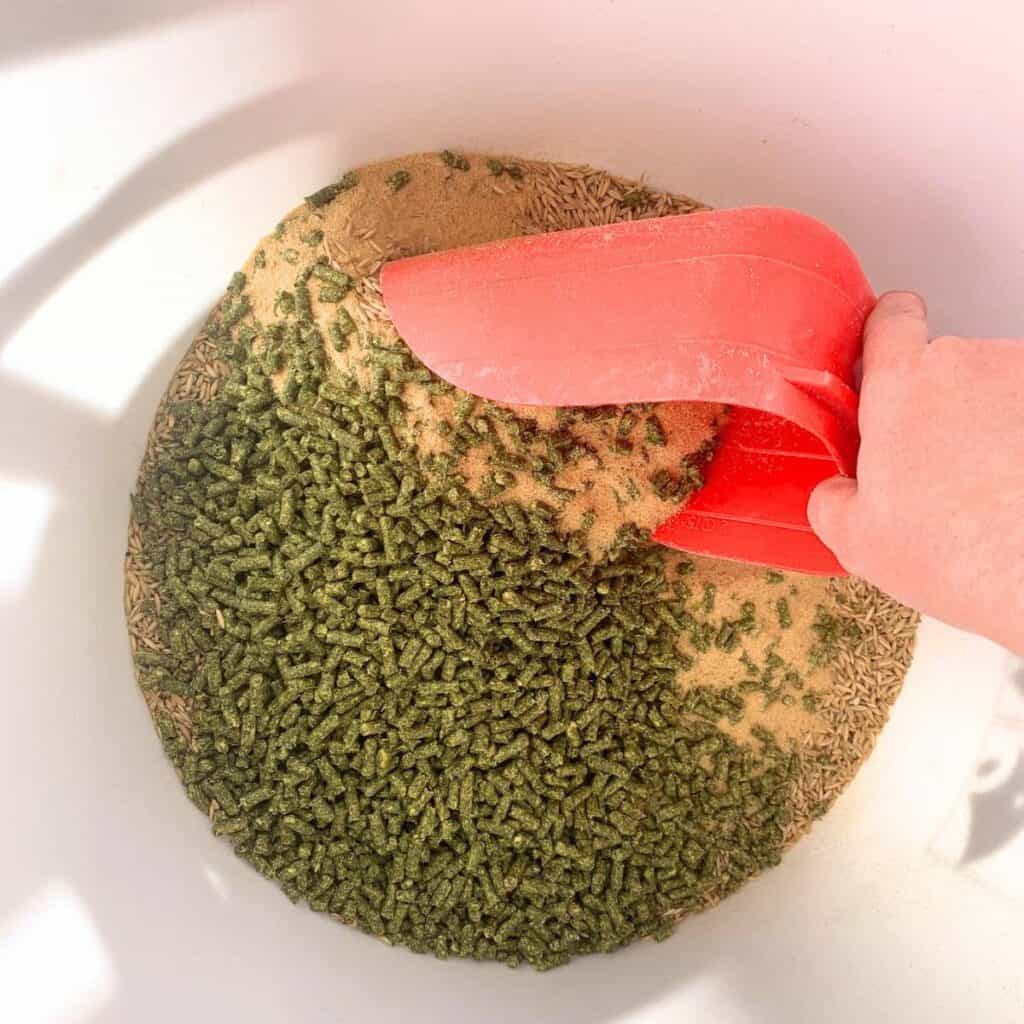
Mix all the ingredients together with your scoop.
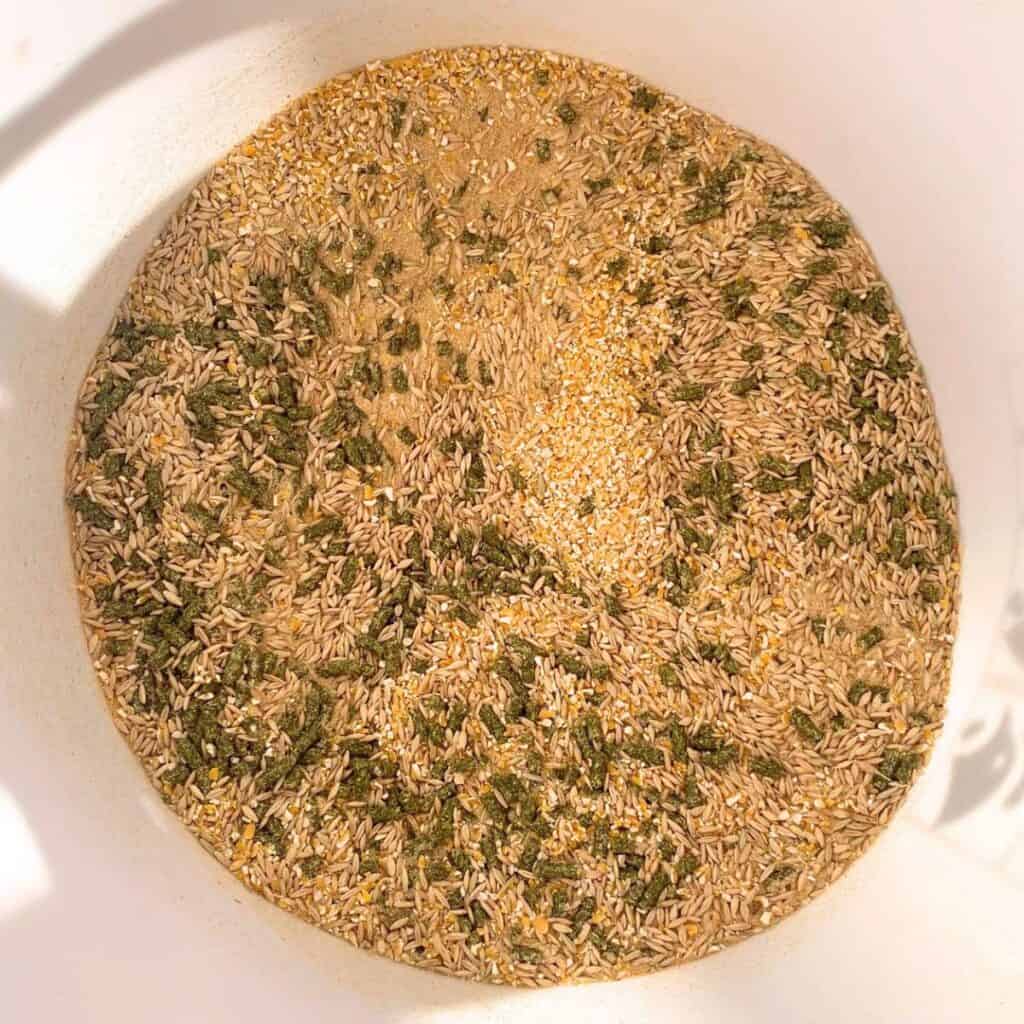
Your mixed organic feed for dairy cows should be pretty well combined at this point.
Keep going until you use all your bags of feed. Using the same bags from Azure Standard that I use, your feed should fill up a larger and medium size storage container.
And that’s it!
Reasons to make organic feed for dairy cows.
- If you’re going to feed your dairy cow, giving them an organic option will avoid the toxins of non-organic feed being passed through to the milk.
- You would want to give your cow a dairy ration if their body requires it to produce milk, and they would get too skinny and unhealthy without it.
- Feeding your cow a dairy ration will keep them still and occupied in the stanchion when it’s milking time.
- Giving your cow a dairy ration will build up their muscle and fat.
- You would want to give your cow a dairy ration to increase the amount of milk they produce. For example, some farmers milk up to three times per day.
Reasons not to make organic feed for dairy cows.
- You don’t want to give your cow a dairy ration if your cow can produce milk and maintain her body weight while on a strict grass (and hay) diet…and having 100% grass-fed milk is important to you.
- If you’re not going to feed your dairy cow organically, you don’t need to make organic feed for her.
- You don’t want to give your cow a dairy ration when you are drying her off. See the section on Milk Fever, below.
- You don’t want to give your cow a dairy ration if you are trying to reduce the amount of milk she produces.
Why should you make organic feed for dairy cows at home?
Did you know that a lot of animal feed that you buy, if it is not labeled “organic”, then it probably has pesticide and other toxic chemical residue in it? Then, when you feed it to your dairy cow, those chemicals can pass on to you the consumer through the dairy milk.
I recently watched some of my favorite homestead YouTubers mention that they were getting sick. Eventually, they traced it to non-organic animal feed they were giving their animals.
Glyphosate toxicity was the issue for them, and they were facing cancer and other illnesses. Fortunately, they found out in time and are now on the road to recovery, which includes several months of detoxing to get that stuff out of their system.
Thank the Lord for good doctors and lab technicians!
Dairy feed and milk fever
You should never give your dairy cow a dairy ration when you are trying to dry her off. Drying off your cow means that you are reducing the time that you milk and the amount of milk that you take from your dairy cow in order to dry her off. That means you’re getting her to stop producing milk.
You generally only dry off your cow right before they have their next calf. That way they can have a two or three month break where all their food energy can go into creating a big healthy baby calf instead of into milk production.
If you give your dairy cow a dairy ration when you’re trying to dry her off, you run the risk of milk fever.
Milk fever is potentially life-threatening. If you don’t catch milk fever in time, the rich grass or rich grain ration will make their body want to produce milk. And if you’re not milking out your dairy animal, they get engorged and it can lead to mastitis, other infections, or milk fever, and potentially even death.
How often should dairy cows be fed a dairy ration?
It depends on your specific cow, pasture, and priorities, but you could feed your dairy cow a dairy ration the same number of times that you milk them per day. For example, if you milk once per day, they would be fed a dairy ration in their stanchion once per day. If you milk twice per day, they get fed twice per day.
Some commercial dairy farms feed their cows three times per day or more so that they can get more milk. I wouldn’t recommend that for small farmers and homesteaders. There is a point when that gets too expensive, both in dollars and in our time.
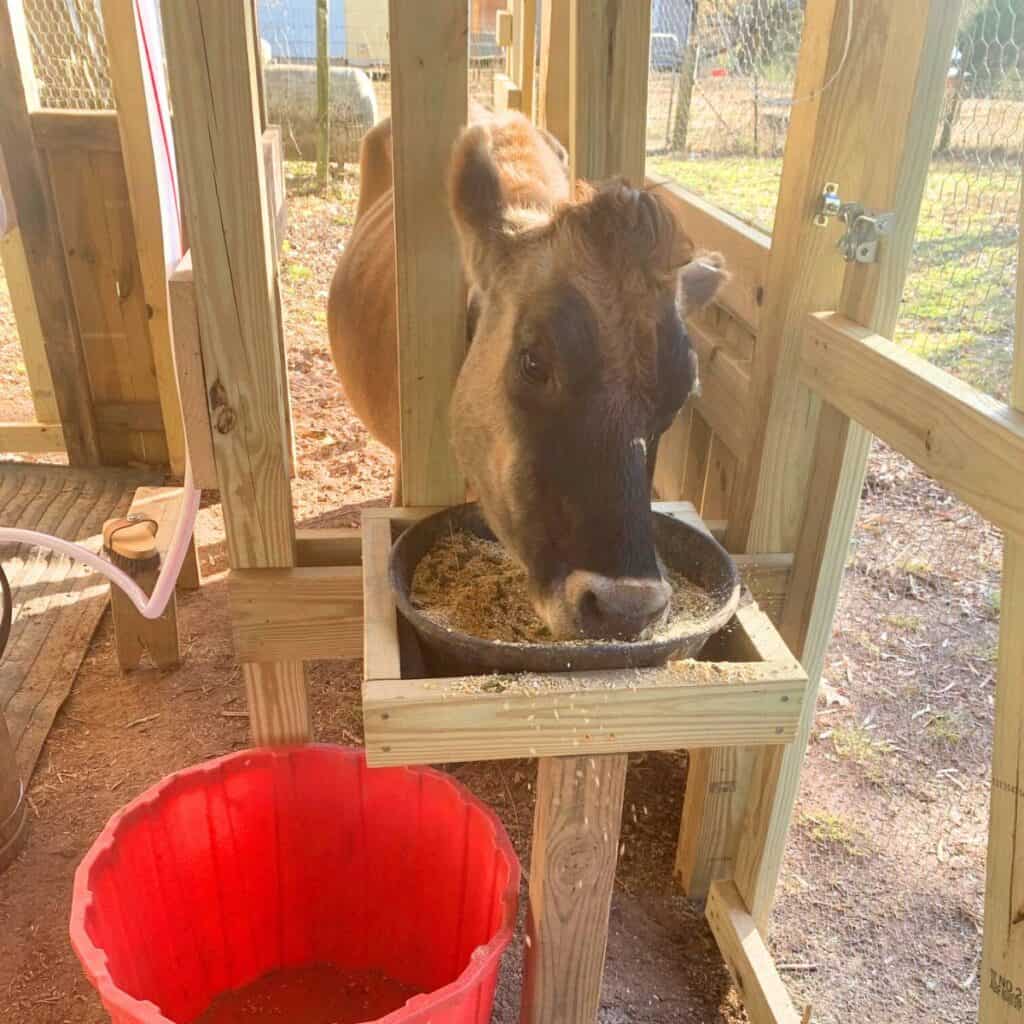
How much should you feed a dairy cow per day?
How much you feed your dairy cow per day will depend on your setup and your resources. If you are milking by hand, it will take you longer to milk her out and she will eat more. If you have a milk machine, it takes less time to milk her out and she will eat less.
We have a Melasty milk machine now, but we used to milk Belle and another dairy cow we were babysitting by hand. When we milked by hand, the cows wouldn’t stand still unless they had their dairy ration in front of them.
When we are hand milking, it takes us about 15 to 20 minutes to milk a cow out. During that time, the cows would eat six scoops of dairy ration. Our scoops are mostly 5-pint utility scoops, and we keep them in the containers of feed.
Roughly, 1 pint = 2 cups = 16 ounces = 1 pound. Therefore, 5 pints (a “scoop”) = 5 pounds.
Hand-milking for 15 to 20 minutes: Six “scoops” = 30 pounds of feed. With our grain mixture costing us $0.59/pound, that totals $17.70 per milking session.
The Melasty milk machine cut our time in the stanchion down to just 7 minutes. In that time, our dairy cow eats four scoops of feed.
Machine-milking for 7 minutes: Four “scoops” = 20 pounds of feed. With our grain mixture costing us $0.59/pound, that totals $11.80 per milking session.
How feeding grain affects milk production.
Feeding grain increases the amount of milk dairy cows produce. How much of an increase depends on the cow, but the extra protein, plus the tasty snack waiting for them in the stanchion, is something dairy cows crave.
Unlike lactating human women, dairy cows have the ability to start and stop the flow of milk coming out. I find that when our cows have grain in their bowls rather than hay or grass clippings, they have a fast let-down and give us more milk.
Happy cows equals more milk and cream for us!
PennState Extension wrote an interesting article if you would like to learn more: Economics of Supplemental Feeding with Pasture-Based Systems. They found that when supplemental grain is fed, milk yield increases and concurrently, fat yield increases.
But for the average homesteader, it ultimately will come down to your resources, your time, and your priorities. There are successful homesteaders who choose dairy cows that don’t need supplemental grain to produce milk to meet their family’s needs.
Brushing your cow and talking lovingly to her increases milk production, too, in my opinion. So choose what works best for you, your cow, and both your needs in the end.
Shop This Post
26.5 gallon locking tubs with lids
Pin It For Later!
